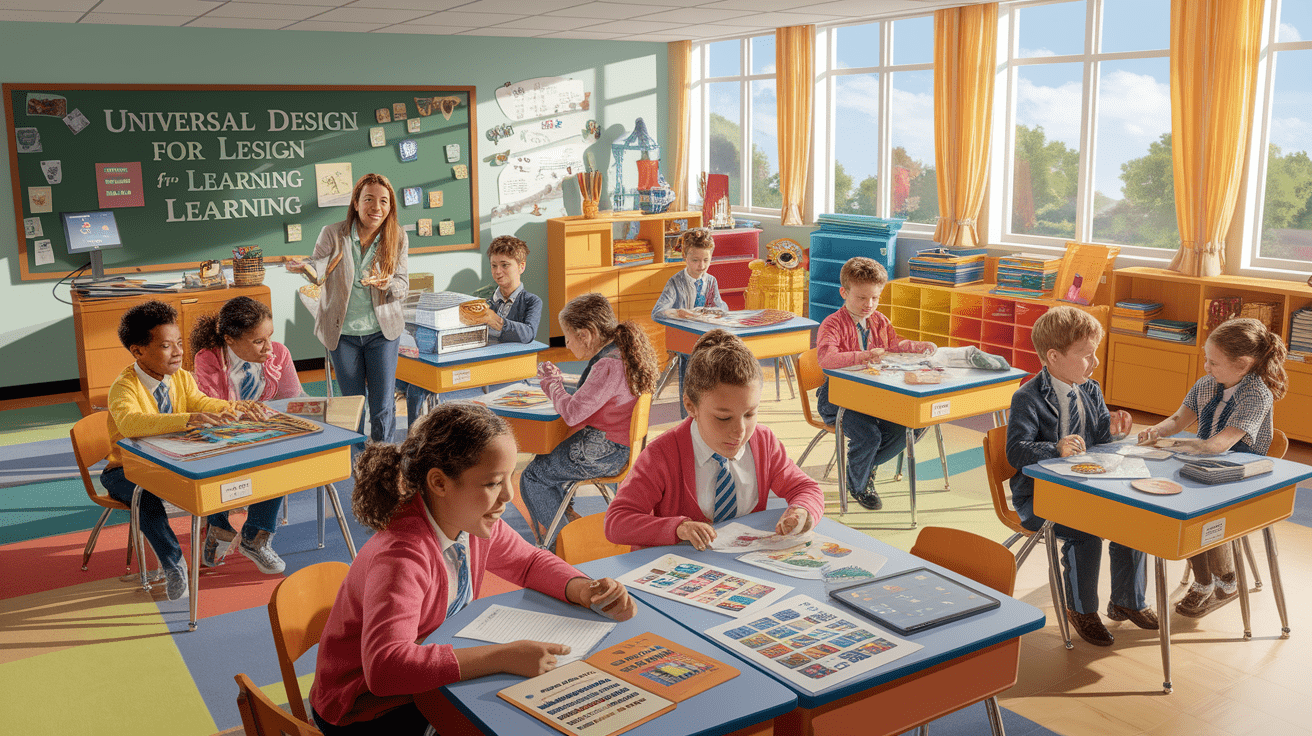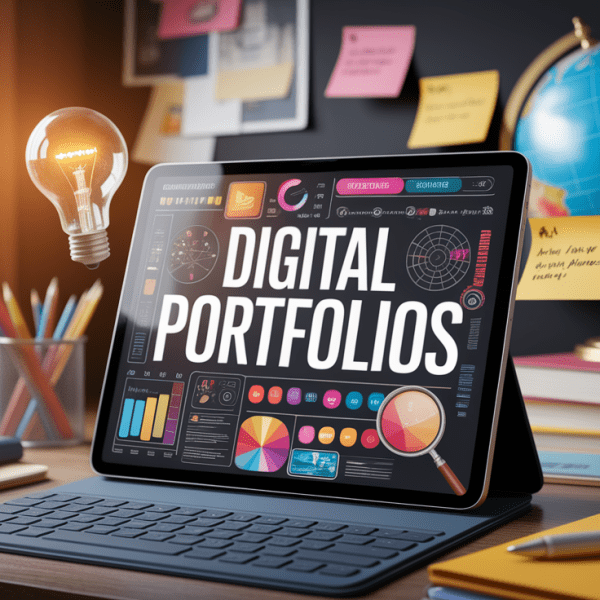Imagine walking into a classroom where every student feels seen, heard, and empowered to learn in their own unique way. That’s the magic of Universal Design for Learning (UDL) – and the best part? You’re about to discover how to make it happen in your own classroom! Whether you’re a seasoned educator looking to refresh your approach or a new teacher eager to create inclusive spaces from day one, this guide will help you transform your lesson planning process into something truly extraordinary.
Rolling Out the Inclusive Red Carpet
Think of UDL as rolling out the red carpet for every single learner who walks through your classroom door. Developed by CAST, this educational framework isn’t just another teaching trend – it’s a brain science-backed approach that recognizes a fundamental truth: there’s no such thing as an “average brain.”

Universal Design for Learning replaces those rigid “one-size-fits-all” lesson plans with flexible, proactive designs that eliminate learning barriers before they even appear. It’s like being a master chef who doesn’t just make one dish, but creates a buffet where every guest finds something that delights their taste buds!
But here’s what makes UDL truly revolutionary: it’s not about “fixing” students or retrofitting accessibility as an afterthought. Instead, it’s about optimizing the learning environment from the ground up. As CAST beautifully puts it, we’re nurturing flowers by adjusting the soil and sunlight, not trying to change their biology.
This shift toward inclusive education benefits everyone – from neurodiverse learners to English Language Learners, from students with temporary anxiety to those who simply learn differently. When you embrace UDL principles, you’re not just teaching; you’re creating equity in education and fostering accessible learning for all.
The Three Pillars of UDL in Practice
Ready to dive into the heart of UDL? The framework rests on three interconnected principles that work together like a perfectly choreographed dance. These UDL Guidelines aren’t just theoretical concepts – they’re your practical roadmap to creating lessons that truly work for every learner.

Multiple Means of Engagement: Lighting the Fire of Learning
This first pillar focuses on the “why” of learning – tapping into your students’ motivation and giving them agency over their educational journey. When you provide multiple means of engagement, you’re connecting learning goals directly to what makes each student tick.
Picture this: instead of assigning the same essay to everyone, you offer tiered assignments where students can choose between writing a traditional paper, creating a podcast, or designing an infographic. Suddenly, that student who dreads writing but loves visual design is just as engaged as your budding journalist!
Try incorporating collaborative projects that tackle real-world issues, or set up classroom debates on current social issues. These differentiation strategies help you meet students where their interests lie while still achieving your curriculum goals.
Multiple Means of Representation: Opening Every Door to Information
The second pillar addresses the “what” of learning by providing various ways for students to access and process information. This is where your creativity as an educator really shines!
Instead of relying solely on textbooks, you might present climate data through colorful charts for visual learners, engaging podcasts for auditory processors, and hands-on experiments for those who need to touch and manipulate to understand. You’re essentially creating a multimedia experience that caters to different learning styles.
Consider using sign language interpretations, interactive diagrams, or even adjusting content complexity based on individual needs. The goal is to ensure every student can access the information, regardless of how their brain processes it best.
Multiple Means of Action and Expression: Celebrating Every Voice
The third pillar focuses on the “how” of learning – giving students flexible ways to demonstrate their understanding. This is where traditional assessment gets a beautiful makeover!
Instead of forcing every student to write a research paper, you might allow them to choose between creating a written essay, filming a documentary, building a model, or delivering a presentation. One student might excel at written communication while another shines in oral storytelling – and both approaches can demonstrate mastery of historical events just as effectively.
Providing scaffolding tools like writing templates, graphic organizers, or speech outlines ensures every student has the support they need to succeed, regardless of their starting point.
Blueprint Your UDL-Infused Lessons
Now comes the exciting part – transforming your lesson planning process with UDL principles! Creating accessible lesson plans using UDL guidelines doesn’t mean starting from scratch; it means enhancing what you already do with intentional flexibility.

Start with Clear, Flexible Goals
Before diving into activities, establish clear learning goals and objectives that focus on the essential learning, not the method of learning. Ask yourself: “What do I want students to know, understand, or be able to do?” rather than “How do I want them to show me?”
Your learning objectives should be specific enough to guide instruction but flexible enough to accommodate different paths to mastery. This approach to curriculum design ensures you’re focusing on the destination while allowing multiple routes to get there.
Design with Diversity in Mind
When planning your instructional strategies, think about the diverse learners in your classroom from the very beginning. This proactive approach is what sets UDL apart from traditional lesson planning.
Consider questions like: How can I present this information in multiple formats? What choices can I offer for student engagement? How can students demonstrate their learning in different ways? This mindset shift transforms rigid lesson plans into adaptable templates that prioritize learner autonomy.
Embed Choice Throughout
Choice is the secret ingredient that makes UDL lessons come alive! Build options into every phase of your lesson – from how students access information to how they process it and express their understanding.
You might offer reading materials at different complexity levels, provide both video and text explanations, or create learning stations where students can choose their preferred mode of engagement. The key is ensuring that all choices lead to the same learning goals.
Classroom-Ready Strategies for Every Learner
Let’s get practical! Here are some tried-and-true examples of UDL strategies in the classroom that you can implement tomorrow.

Engagement Strategies That Work
- Choice Boards: Create menus of activities where students can select tasks that align with their interests and strengths
- Real-World Connections: Link lessons to current events, community issues, or students’ personal experiences
- Collaborative Learning: Design group projects that allow students to contribute their unique strengths to a collective goal
- Student Voice: Regularly ask students what works for them and adjust accordingly
Representation Strategies for Access
- Multimedia Resources: Combine text, audio, video, and interactive elements in every lesson
- Graphic Organizers: Provide visual frameworks to help students organize information
- Adjustable Complexity: Offer the same content at different reading levels or complexity levels
- Multisensory Approaches: Incorporate visual, auditory, and kinesthetic elements into instruction
Expression Strategies for Assessment
- Portfolio Options: Allow students to showcase learning through collections of their best work
- Performance-Based Assessment: Let students demonstrate knowledge through presentations, demonstrations, or performances
- Digital Tools: Provide technology options for students to create and share their work
- Flexible Timelines: Offer extended time or alternative pacing for students who need it
Supporting English Language Learners
UDL naturally aligns with supporting diverse learners, including English Language Learners. When integrating ELD standards into your UDL framework, consider providing visual supports, encouraging native language use as a bridge to English, and offering multiple ways for students to demonstrate comprehension beyond traditional language-heavy assessments.
Tech and Tools to Simplify UDL Adoption
Technology can be your best friend when implementing UDL! The right assistive technology and digital tools can make personalized learning more manageable and effective.
Essential UDL Technology Tools
- Text-to-Speech Software: Helps students access written content through audio
- Voice Recognition Tools: Allows students to dictate instead of type
- Interactive Whiteboards: Creates engaging, multisensory learning experiences
- Educational Apps: Provides gamified learning opportunities and skill practice
- Video Creation Tools: Enables students to demonstrate learning through multimedia projects
Low-Tech, High-Impact Solutions
Don’t worry if your technology budget is limited! Many effective UDL strategies require minimal or no technology:
- Flexible seating arrangements (standing desks, floor cushions, wobble chairs)
- Printed graphic organizers and templates
- Manipulatives and hands-on materials
- Alternative writing tools (colored pens, different paper types)
- Timer tools for managing work sessions
Making Technology Accessible
When using technology to support UDL in lesson plans, ensure all digital content is accessible. This means using captions on videos, alt-text for images, and ensuring compatibility with screen readers. These small steps make a huge difference for students with disabilities while benefiting all learners.
Reflect, Adjust, and Grow
Implementing UDL is a journey, not a destination! The beauty of this framework lies in its emphasis on continuous improvement and responsive teaching.
Gathering Student Feedback
Your students are your best consultants when it comes to what’s working and what isn’t. Create regular opportunities for them to share feedback about their learning experiences. This might include:
- Exit tickets asking what helped them learn best that day
- Learning preference surveys to understand individual needs
- One-on-one check-ins to discuss what’s working
- Peer feedback sessions where students share successful strategies
Professional Development and Growth
Successful UDL implementation often requires professional development on UDL lesson planning. Seek out workshops, online courses, or professional learning communities focused on inclusive education practices. The investment in your own learning will pay dividends in your students’ success.
Collaborative Problem-Solving
Don’t go it alone! Partner with colleagues, special education specialists, and other support staff to brainstorm solutions for implementation challenges. Sometimes the best ideas come from casual conversations in the teachers’ lounge or collaborative planning sessions.
Celebrating Small Wins
Remember to celebrate progress, not perfection! Every time you offer a choice, provide an alternative format, or see a previously disengaged student light up with interest, you’re making a difference. These small victories are the building blocks of transformative change.
The Inclusive Encore: Bringing UDL to Life
As we wrap up this journey into UDL implementation, remember that you’re not just changing how you teach – you’re changing lives. When you create inclusive learning environments that honor every student’s unique strengths and needs, you’re preparing them not just for academic success, but for life success.
The benefits of using UDL for diverse learners extend far beyond the classroom. You’re cultivating critical thinking, creativity, and self-advocacy skills that will serve your students throughout their lives. You’re showing them that there are many paths to success and that their unique way of learning is not a limitation but a strength.
Starting your UDL journey might feel overwhelming, but remember: you don’t have to transform everything overnight. Begin with small changes – maybe offer two ways to access content in your next lesson, or provide a choice in how students demonstrate their learning. Each step forward is progress worth celebrating.
The challenges of implementing UDL are real, but so are the rewards. Yes, it requires shifting your mindset from rigid lesson plans to flexible frameworks. Yes, it means curating diverse materials and creating multiple pathways to learning. But the joy of seeing every student engaged, the satisfaction of knowing you’re reaching learners who might otherwise struggle, and the growth you’ll witness in your classroom community make every effort worthwhile.
Your commitment to inclusive education creates ripple effects that extend far beyond your classroom walls. When students experience learning environments where their differences are valued and their needs are met, they carry that sense of belonging and possibility with them wherever they go.
So take that first step, embrace the adventure, and remember – in the world of UDL, every learner has a place at the table, and every teacher has the power to make learning accessible, engaging, and meaningful for all.




